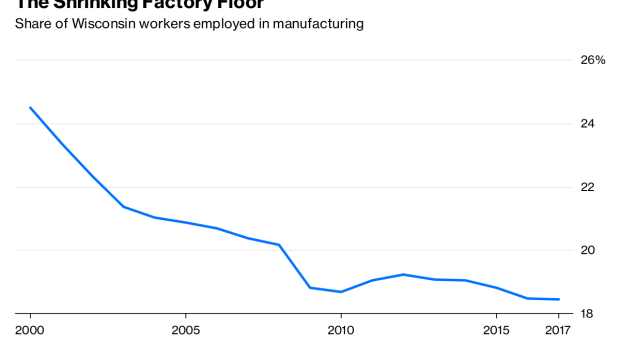Nov 6, 2018
Foxconn and the Folly of State Corporate Welfare
, Bloomberg News

(Bloomberg Opinion) -- Whatever Americans were hoping for when they elected Donald Trump president in 2016, it’s a fair bet that it didn’t include shoveling billions of dollars of American taxpayer money to foreign companies to build white-elephant factories. But it looks as if that is what’s happening in Wisconsin. After Trump suggested that a piece of land in southeastern Wisconsin would be a great place for a factory back in 2017, Taiwanese electronics manufacturer Foxconn offered to build it.
There was just one catch -- the state would have to pay Foxconn a lot of money. About $4.5 billion to be exact. Since the state already has very low tax rates for manufacturers, much of this subsidy will be paid directly in cash rather than as tax credits.
This is a staggering amount of money -- about $1,800 per Wisconsin taxpayer -- for a factory like this. The Foxconn plant will initially employ 3,000 workers, at a salary of about $54,000 a person. Even if the factory eventually increases its employment to 13,000 -- as Wisconsin Governor Scott Walker has promised that it will -- the cost per job created would be about $346,000. If the number of jobs turns out to be lower, the cost per job will be higher. Estimates that the state could break even on its investment by 2043 are almost certainly overoptimistic.
If that all sounds like a bad deal, it’s because it is. Tim Bartik, an economist who studies industrial policy, calculates that Wisconsin is paying about 10 times the typical amount per job created. And that’s a best-case scenario. The Taiwanese company isn’t contractually obligated to deliver those 13,000 jobs -- it could decide to ship them to China instead, or even to close the Wisconsin factory in 10 years. In fact, Foxconn has already changed the type of factory it intends to build, switching to a cheaper, less advanced manufacturing process.
It’s kind of amazing that a president who was elected on a promise to extract better deals from foreigners ended up mailing billion-dollar checks overseas in exchange for meager promises. The project looks an awful lot like a politically motivated boondoggle. The state could probably do better for its workers by simply employing them directly, or by giving them a basic income -- at least then the money would stay in the country instead of getting mailed to Taiwan.
While the Foxconn fiasco is a particularly egregious example, the whole approach of paying companies to relocate is coming under increasing scrutiny. Lots of cities and states play this game -- estimates of total local corporate subsidies range from $45 billion to $90 billion a year. Most of this is in the form of tax credits. The bidding war for what Amazon.com Inc. calls its second headquarters is a prime example.
Fundamentally, corporate welfare is a zero-sum game -- if all cities and states could simply agree not to give any incentives, companies would still have to put their offices and factories somewhere. What’s more, the money often gets wasted. A 2002 paper by economists Todd Gabe and David Kraybill found that Ohio’s business incentives in the 1990s ended up costing more than they were worth. A recent report by Bartik found that incentives tend to yield short-term benefits that are outweighed by the long-term costs. Governments often fail to monitor whether the company is delivering over time.
Even before the Foxconn debacle, the incentive approach wasn’t working very well for Wisconsin. Walker began giving tax breaks to manufacturers in 2012, and eliminated state corporate taxes for manufacturers in 2014. But the percentage of the state’s workers employed in manufacturing has continued falling:
A smarter approach is needed. Bartik’s report has a number of suggestions for how governments can make their corporate incentives more targeted and create more accountability for how the money is spent. Perhaps the best approach for state and local governments is to focus on creating the right conditions for businesses to move in, by doing the things that most business can’t or won’t do.
One example is infrastructure: every business wants its offices and factories to be in a city has good roads, transit, internet, water and other critical support systems. Education is another -- vocational schools can provide the trained workers that companies draw on, while universities create a pool of high-skilled employees. Universities are also useful for doing research that companies can then leverage to their advantage. Beyond universities and infrastructure, governments can focus on creating attractive downtowns and other spaces for young, skilled workers to enjoy, and on forging public-private partnerships to boost local development. These approaches are all hallmarks of the successful local revitalization stories observed by James and Deborah Fallows in their book “Our Towns: A 100,000-Mile Journey into the Heart of America,” and the model generally agrees with researchers’ findings.
If leaders such as Trump and Walker really want to revitalize the country’s languishing regions and jump-start local economic development, instead of engaging in political posturing and white-elephant projects, they should consider approaches like these. They’re not as spectacular as building overpriced showpiece projects like the Foxconn plant, but in the long run they will help a lot more Americans at lower cost.
To contact the author of this story: Noah Smith at nsmith150@bloomberg.net
To contact the editor responsible for this story: James Greiff at jgreiff@bloomberg.net
This column does not necessarily reflect the opinion of the editorial board or Bloomberg LP and its owners.
Noah Smith is a Bloomberg Opinion columnist. He was an assistant professor of finance at Stony Brook University, and he blogs at Noahpinion.
©2018 Bloomberg L.P.





